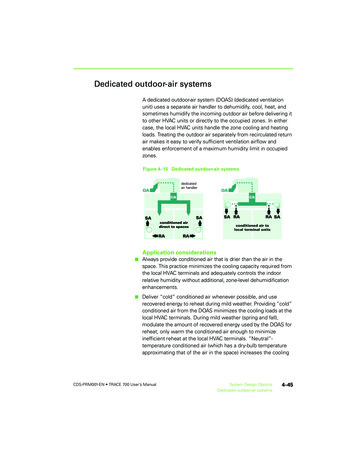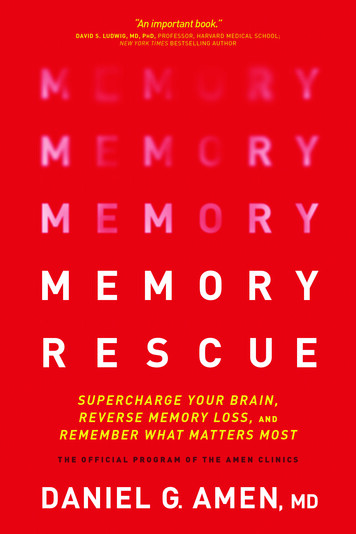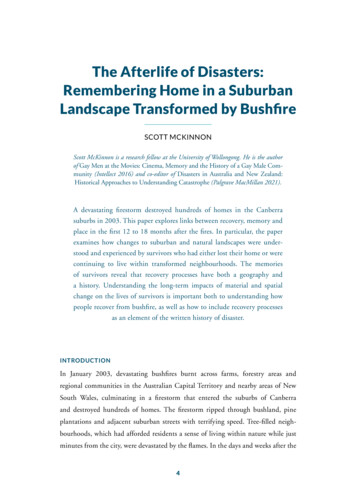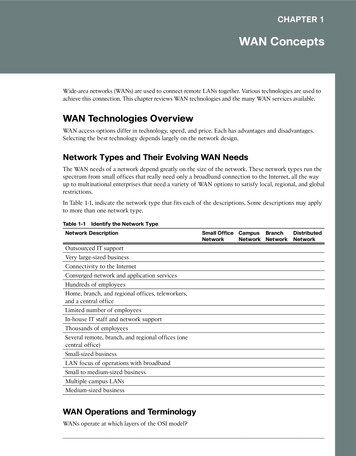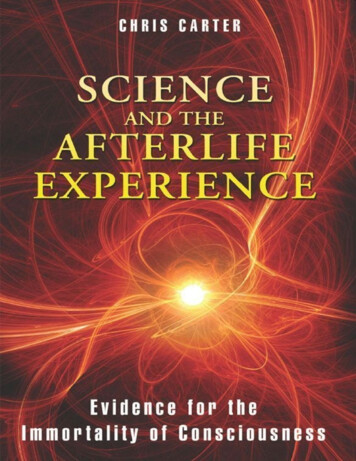
Transcription
Dedicated to the memories of Curt Ducasse, John Eccles, and Frederic Myers, three remarkable individuals who never let fashiondictate their opinions.
SCIENCEAND THEAFTERLIFE EXPERIENCE“The evidence in favor of an afterlife is vast and varied. The evidence from near-death experiences and deathbed visions wasdescribed in two previous books by Chris Carter. Science and the Afterlife Experience is the final work of his trilogy, and one willsee in this wonderful book that we do indeed have strongly repeatable evidence for the continuity of consciousness after physicaldeath, based on children who remember previous lives, reports of apparitions, and communication from the deceased. What allthese cases show is that human personality survives death and, by implication, human consciousness can exist independently of afunctioning brain. When one has read the overwhelming evidence as described in this excellent book, it seems quite impossible notto be convinced that there should be some form of life after death. Any continuing opposition to the evidence is based on nothingmore than willful ignorance or ideology. Highly recommended.”PIM VAN LOMMEL, M.D., CARDIOLOGIST ANDAUTHOR OF CONSCIOUSNESS BEYOND LIFE“Chris Carter addresses the question that is, or should be, the single most important question for any being who considers himself—or suspects himself to be—mortal. He argues that this is not the case. If he is right then this is not only the single most lifetransforming realization for a mortal or perhaps immortal being but also one of the most potent realizations that could prompt sucha being to enter on a better path during his or her known life.”ERVIN LASZLO, PH.D., AUTHOR OFSCIENCE AND THE AKASHIC FIELDAND THE NEW SCIENCE AND SPIRITUALITY READER“. . . some of the best evidence offered by the near-death experience. This book is informative, interesting, intriguing, andinspirational.”MICHAEL TYMN,AUTHOR OF THE AFTERLIFE REVEALEDAND THE AFTERLIFE EXPLORERS“This third volume of Chris Carter’s trilogy may be the best. Reincarnation, ghostlike visions, and messages from the dead makefor some very stimulating reading. As an historical chronicle alone this would be a valuable work. But Carter’s historical treatmentalso combines philosophy and analysis into an always interesting and well-organized treatise.”ROBERT BOBROW, M.D.,AUTHOR OF THE WITCH IN THE WAITING ROOM“The statement ‘Survival of human consciousness past the point of biological death is a fact’ will seem an extraordinary claim tosome, and they may reasonably demand extraordinary evidence to support it. Carter has both made the claim and provided theevidence.”GUY LYON PLAYFAIR, AUTHOR OF THIS HOUSE IS HAUNTED, IF THIS BE MAGIC, AND TWIN TELEPATHY“Carter boldly concludes that the survival of consciousness after the death of the body is a scientific fact—as well established asany other scientific fact.”NEAL GROSSMAN, PH.D., PROFESSOR EMERITUSOF PHILOSOPHY, UNIVERSITY OF ILLINOIS AT CHICAGO“Chris Carter has produced a compelling synthesis and brilliant analysis of some of the best evidence for life beyond physicaldeath. This book should be required reading for believers and skeptics alike.”GARY E. SCHWARTZ, PH.D., PROFESSOR OF PSYCHOLOGYAND MEDICINE AT THE UNIVERSITY OF ARIZONA ANDAUTHOR OF THE AFTERLIFE EXPERIMENTS“Chris Carter establishes the existence of the afterlife beyond a reasonable doubt. I congratulate him on such a solid synthesis ofthe relevant data and arguments—both for and against.”
EBEN ALEXANDER III, M.D.,AUTHOR OF PROOF OF HEAVEN: A NEUROSURGEON’SNEAR-DEATH EXPERIENCE AND JOURNEY THROUGH THE AFTERLIFE“In this wonderful book, a work of great erudition, Chris Carter succinctly examines the works of giants in the field of survival ofconsciousness. . . . Carter’s careful analysis of evidence for survival promptly lays super-ESP counterarguments to rest. . . . Ihighly recommend this book to the serious student.”JOHN L. TURNER, M.D.,AUTHOR OF MEDICINE, MIRACLES, AND MANIFESTATIONS
Contents1.Title 6.Psychic Phenomena and the Near-Death Experience1.2.3.4.5.6.7.BASIS OF THE CONTROVERSYMODERN PHYSICS DOES NOT PROHIBIT PSI PHENOMENATHE RELATIONSHIP BETWEEN MIND AND BRAINTHE TRANSMISSION HYPOTHESISTHE PRODUCTION HYPOTHESISDENIERS, DEBUNKERS, AND MILITANT ATHEISMPART I: Reincarnat ion1. Chapter 1: Evidence from India to Eng land2. Chapter 2: Characteristics of Reincarnation Cases1. BEHAVIORAL SIMILARITIES2. FACTORS INFLUENCING REINCARNATION3. Chapter 3: Alternative Explanations for Reincarnation Evidence1. POPULATION INCREASE AND REINCARNATION2. FRAUD3. CULTURAL FANTASY4. Chapter 4: The Objections of Paul Edwards5. Chapter 5: Reincarnation in Review1. DOES TELEPATHY OR ESP ACCOUNT FOR REINCARNATION EXPERIENCES?8.PART II: Apparit ions1. Chapter 6: Strang e Visits1. REPORTS FROM CHILDREN2. APPARITIONS OF ANIMALS2. Chapter 7: Characteristics and Theories of Apparitions
1. TYPES OF APPARITIONS2. THEORIES OF APPARITIONS3. Chapter 8: What Underlies Ghostly Visions?1.2.3.4.COLLECTIVELY PERCEIVED APPARITIONSAPPARITIONS OF THE LIVINGAPPARITIONS WITH THEIR OWN AGENDAVERIDICAL APPARITIONS4. Chapter 9: Final Thoug hts on Apparitions9.PART III: Messages from t he Dead1. Chapter 10: Ancient Evidence2. Chapter 11: The SPR Investig ates3. Chapter 12: Alternative Explanations1.2.3.4.5.CONSCIOUS FRAUDSUBCONSCIOUS FRAUDESP AND SUBCONSCIOUS FRAUDDIFFICULTIES WITH ESP AS AN EXPLANATIONALTERNATIVE EXPLANATIONS: CONCLUSION4. Chapter 13: Super-ESP as an Explanation?1.2.3.4.5.6.PURPOSE CONTRARY TO THAT OF THE MEDIUM OR SITTERSCOMMUNICATION FROM THE PERSPECTIVE OF THE DECEASEDMANIFESTATIONS OF PERSONALITYMANIFESTATIONS OF SKILLSTHE LANGUAGE CASESSUPER-ESP: CONCLUDING THOUGHTS5. Chapter 14: Cross Correspondences1. CAST OF CHARACTERS2. EARLY MESSAGES6. Chapter 15: The Lethe Experiment1. COMMENTS ON THE LETHE EXPERIMENT2. IDIOSYNCRASIES IN THE SCRIPTS3. LODGE CONTINUES THE LETHE EXPERIMENT7. Chapter 16: Evaluation of the Cross Correspondences1.2.3.4.CHANCEFRAUDSUPER-ESP AND SUBCONSCIOUS FRAUDSURVIVAL
10.PART IV: Conclusions1. Chapter 17: How the Case for Survival Stands Today1. MOTIVE BEHIND THE SUPER-ESP HYPOTHESIS2. SURVIVAL: CONCLUDING REMARKS2. Chapter 18: Is Survival a Fact?1. THEORY OF KNOWLEDGE3. Chapter 19: What the Dead Say1. THE WORLD OF THE DEAD11.Epilogue12.Appendix: The Dream t the Author17.About Inner Traditions Bear & Company18.Books of Related Interest19.Copyright & Permissions
The answer to human life is not to be found within the limits of human life.CARL JUNG
ForewordBy Robert AlmederI am a philosopher, and skeptics on the possibility of life after death occasionally defend their skepticism with reasons that arephilosophical. Take, for example, three of the most popular philosophical arrows in the skeptic’s quiver.The first is that the very idea of humans existing independently of their bodies is inconceivable or incoherent. It makes no sense, theysay, to talk about personal survival after death, either because we cannot imagine what a human person is if it is not at least partiallyidentifiable with a unique human body or else because the very idea of surviving one’s death is conceptually incoherent. We are ourbodies, so they say. In the end, of course, this objection is rooted in the mistaken belief that just because we may not be able to imaginewhat a disincarnate human is like without a human body, there cannot be any.However, the history of science shows again and again that a failure of imagination provides no compelling reason to doubt claimsthat are supported by the evidence. Reports of rocks that fall from the sky—what we today call meteorites—were rejected by scientistsfor decades on the grounds that there are no rocks in the sky to fall. Continental drift was ridiculed by geologists for decades becausethey could not imagine any means by which the continents could drift. The incredible claims of quantum mechanics may forever defy ourability to imagine them. And, finally, we might just find very strong evidence for accepting the ancient belief in the existence ofdisincarnate persons even if they are not physical bodies as we generally describe them in natural science.The second objection is that even if human survival of death were logically and factually possible, we still have no scientificknowledge of anybody ever surviving biological death, because we have no experimental evidence for it that will hold up under seriousscientific scrutiny. We cannot, so the objection goes, generate at will compelling case studies; we cannot control disembodied spirits inorder to make them appear under empirically desirable conditions. Any evidence offered for the survival of humans or humanconsciousness after death is not repeatable under controlled conditions. Unless the evidence can be repeated at will under controlledconditions, the belief cannot transcend the anecdotal into the realm of human knowledge.However, there are many things we know exist that cannot be repeated at will. The fact that home runs cannot be repeated at willdoes not mean that home runs do not occur. We now know that rocks do sometimes fall from the sky, even though we cannot produce atwill the evidence for this belief. Unique historical events cannot ever be repeated. Even so, as you will see in this wonderful book we doindeed have strongly repeatable evidence based on reincarnation studies, reports of apparitions, and apparent communication from thedeceased via mediums.The third objection is that the evidence for personal survival is persuasive only if the ever-present possibility of fraud or hoax can beclearly excluded. But the possibility of fraud or hoax can never be completely excluded in any field. Even so, we do not need tocompletely exclude all logical possibility of fraud. We only need the continual widespread emergence of cases that have the samecharacteristics as the ideal cases (of the sort you will find in this book). When enough cases continue to occur and are examined by manydifferent researchers who are incapable of finding any fraud, over time the probability of fraud becomes remote, just because such casesare repeating themselves in widely differing contexts and in the hands of different researchers. As the esteemed Cambridge philosopherHenry Sidgwick remarked in his presidential address to the British Society for Psychical Research in 1882, “We have done all we canwhen the critic has nothing left to allege except that the investigator is in the trick.”1This is not the place to examine closely all the arguments offered by the skeptics who advance them against the more persuasivearguments for personal survival. But the author of this book has written two other books on the skeptical arguments, and he has done anadmirable job in showing just how terribly superficial the skeptical arguments are, primarily because skeptics typically come to thediscussion with a deeply rooted bias that undermines the spirit of inquiry based on the facts.This sort of bias is nothing new. It is a tribute to William James to keep in mind his claim that progress in the area of paranormalresearch and belief in life after death will be a slow process more likely to occur incrementally as the product of sustained research inthe area. James suggested that skepticism in this area dies slowly because of the deep cultural and religious influences on the formation ofbelief. Even so, for those who have studied carefully the various bodies of evidence for belief in some form of human survival it issomething of a mystery why some members of the scientific community still resist serious research into this belief.The author of this book, like so many others, is less motivated by some need to refute skeptics than he is in reaching those who cometo the issue with an open mind and who are not fearful of learning that which may challenge their present beliefs. Even so, as you willsee, his careful criticisms of the skeptical position are more than enough to put the typical skeptic in his or her place.As a matter of fact, when you finish reading this book, you will probably find the arguments for survival and against the skeptics socompelling that you will come to view death not as a sad extinction of one’s personality but rather as a joyful beginning in a differentdimension of existence. As philosopher Alice Bailey put it:We can live in the consciousness of immortality, and it will give an added coloring and beauty to life. We can foster the awarenessof our future transition, and live with the expectation of its wonder. Death thus faced, and regarded as a prelude to further living
experience, takes on a different meaning.2Even so, the ultimate question may not be whether we are strongly justified in believing some form of life after death, although that iscertainly an important question. Rather the question is more properly whether that belief is more rationally justifiable than its denial quiteindependent of whether one believes or disbelieves it. In the meantime, we can continue to argue that not only is it reasonable to believein some form of life after death, but more interestingly, that it is irrational not to believe, based purely on the force of the availableevidence.ROBERT ALMEDER, PH.D., is a professor of philosophy at Georgia State University. A former Fulbright scholar, he is the author ofTruth and Skepticism and Death and Personal Survival: The Evidence for Life after Death.
IntroductionThe major problem of our time is decay in the belief in personal immortality.GEORGE ORWELLThe manner in which we live our lives depends, to a large extent, on what we believe comes after it. Men and women throughout historyhave willingly gone to their deaths for their spiritual beliefs. Critics may point out that human beings have also committed grave atrocitiesand even launched wars motivated, at least in part, by “spiritual” beliefs inspired by the various religions. On the other hand, however,those who believe that death is nothing but oblivion often lead selfish and ruthless lives, concerned only with momentary pleasures,status, and the pursuit of material wealth.Orwell’s grim vision of the future, portrayed in his novel 1984, fortunately did not come to pass. However, we may now face a futureeven worse than anything Orwell imagined. Philosopher David Griffen recently issued this dire warning:I believe the human race now faces the greatest challenge in its history. If it continues on its present course, widespread misery anddeath of unprecedented proportions is a certainty. Annihilation of human life and of millions of species of non-human life as well isprobable. This is so because of polluting technologies, economic growth-mania, out-of-control population growth, globalapartheid between rich and poor nations, rapid depletion of non-renewable resources, and proliferation of nuclear weaponscombined with a state of international anarchy that makes war inevitable and sufficient measures to halt global ecologicaldestruction impossible.What seems clear is that a transition in world order, if it is to occur, will have to be accompanied by a shift in world view, onethat would lead to a new sense of adventure, replacing the modern adventure of unending economic growth based on thetechnological subjugation of nature. Only if we come to see human life as primarily a spiritual adventure, an adventurous journeythat continues beyond this life, will we have a chance of becoming sufficiently free from destructive motivations to affect atransition to a sustainable global order.1Griffen and I both agree that the belief in an afterlife offers several practical benefits:Such a belief can help overcome the fear of death and annihilation.If people are convinced that they are ultimately not subject to any earthly power, this can increase their courage to fight forfreedom, ecologically sustainable policies, and social justice.If people believe that this life is not the final word, and that justice will prevail in the next life, this can help them withstand theunfairness they encounter in the here and now.The idea of life as an unfolding journey, which continues even after death, can lead to a greater sense of connection with theuniverse as it unfolds into the future.The belief in life after death can help counter the extreme degree of materialism that has pervaded every niche of moderncivilization.The belief that we are on a spiritual journey, and that we have time to reach our destination, can motivate us to think creativelyabout what we can do now—socially, internationally, and individually—to move closer to what we should be in the here and now.But for many of us these practical benefits alone are not sufficient to compel belief. We seek hard evidence that stands up to the mostrigorous critical scrutiny. Years before I even considered writing this book, I sought to find such evidence, and after combing throughnumerous books and journals, I was surprised by the sheer quantity and variety of the evidence for an afterlife. Some of the reports datedback hundreds and even thousands of years. But the most rigorous evidence by far has been gathered in modern times by respectedscientists and scholars, beginning in the closing years of the nineteenth century, and continuing to the present day.However, as a philosopher, I was not content to merely examine the evidence in favor of the survival of death; I knew that anycounterarguments must also be fairly and closely examined if we are to arrive at any solid conclusions. I was aware that severalphilosophers and scientists have doubted or denied that we survive the death of our bodies, and so I began an in-depth study of the
skeptical literature. Through reading, discussion, and the occasional debate, I eventually came to understand not only the “skeptical”arguments, but also the motivations of those who deny so vehemently that there is more to human beings than material bodies.The idea that our minds survive the deaths of our bodies is known as the survival hypothesis, and although many people todayassociate belief in an afterlife with religious faith, it is important to remember that this belief long predates any organized religion. It isfound in the old shamanic spiritual beliefs of hunter-gatherers from around the world, and dates back at least to the Neanderthals, whoburied their dead with flowers, jewelry, and utensils, presumably for use in the next world. Reports of phenomena suggesting thecontinued existence of those who once lived on Earth have come from virtually all known cultures, and have continued into the modernage. As we will see, the most convincing evidence has been gathered under rigorous conditions over the last 125 years.The evidence in favor of an afterlife is vast and varied, and comes from near-death experiences, deathbed visions, children whoremember previous lives, apparitions, and communications through mediums. In my previous book, Science and the Near-DeathExperience, I discuss the first two lines of evidence in depth. In this book I concentrate on the even more impressive last three lines ofevidence.Part 1, “Reincarnation,” explores this ancient idea by examining contemporary reports of children who claim to remember previouslives. Although most people associate a belief in reincarnation with the religions of the Far East, it is shown that this belief has historicallybeen found among cultures all over the Earth. As such, modern reports from children in a variety of cultures and locations are criticallyexamined in order to see how such evidence stands up to critical scrutiny.Part 2, “Apparitions,” considers the ancient and widespread belief that the departed sometimes return to visit the living in the form ofapparitions. We carefully examine accounts of apparitions, including accounts in which they are reported by numerous eyewitnesses,accounts in which animals also seem to perceive them, and accounts in which the apparitions behave with a purpose of their own andsometimes convey information unknown to the living. Skeptics have challenged the testimony of these witnesses, and we carefullyscrutinize these challenges.Part 3, “Messages from the Dead,” evaluates the evidence that the departed are capable of detailed, two-way communication withthe living through talented human mediums. Although this idea can also be traced to ancient times, modern scholarly researchers haverigorously and thoroughly examined the validity of communication through mediums for well over a century. We carefully examinealternative explanations in order to see how well they stand up to the best cases, and the reader will see why mediumistic communicationis considered the most convincing single line of evidence for survival.Finally, part 4, “Conclusions,” summarizes the case for survival as it stands today, based on all of the available lines of evidence.The book concludes with a sample of messages purporting to come directly from the afterworld.The experiences described in the pages that follow have important implications for humanity. Based upon my own experience and thatof many others, I sincerely believe that deeply beneficial changes in our view of the universe and our place within it will be gained bythose who read about these strange and often wonderful experiences, and then take their profound lessons to heart.Most people base their beliefs regarding the afterlife on religious or materialistic faith. But there is a third alternative, one that requiresneither a leap of faith nor the denial of evidence. However, as philosopher Carl Becker has written, this third alternative comes with anunusual requirement:We must always walk a tightrope: we are examining data often ignored by the scientific community and embraced by the religiouscommunity, but we are using methodology that is advocated by the scientific community and ignored by much of the religiousworld. Therefore we should expect to be criticized by dogmatists from both sides of the fence.2The purpose of this book is to examine the most convincing ancient and modern evidence for the existence of the afterlife; to carefullyconsider all the skeptical objections; and finally, to arrive at a solution to this deep and ancient mystery.
Psychic Phenomena and the Near-Death ExperienceBackgroundAlthough this is the third and final book in a trilogy, it is not necessary to read the first two books before reading this one. However,because the first two books contain much of the background for many of the main points of this book, it is useful to summarize here someof their conclusions. Those readers who are interested in pursuing these issues in more depth may always consult the original texts.It is a curious fact that most—although by no means all—of those who doubt or deny the survival of mind past the point of bodilydeath also deny the existence of psychic abilities, such as telepathy. As such, my first book, Science and Psychic Phenomena, wasprimarily concerned with understanding why a substantial minority of the scientific community has been vehemently denying the existenceof psychic abilities such as telepathy for well over a century. At first glance, this may seem very puzzling: Reports of psychic abilitiesdate back to the dawn of history, and come from cultures all over the world. Surveys also show that most working scientists accept thepossibility that telepathy exists,1 and many leading scientists have endorsed and supported psychical research.2Those who call themselves “skeptics” assert that there is no replicable, experimental evidence for the existence of psychic abilities,now commonly called psi (pronounced “sigh”). However, as I described at length in my first book, high-quality, consistent, replicableexperimental evidence for the existence of psi has in fact been provided for decades.3 If this were any other field of inquiry, thecontroversy would have been settled by the data decades ago. However, parapsychology is not like any other field of inquiry. The dataof parapsychology challenge deeply held worldviews, worldviews that are concerned not only with science, but also with religious andphilosophical issues. As such, the evidence arouses strong passions, and for many, a strong desire to dismiss it.BASIS OF T HE CONT ROVERSYIt is impossible to fully understand this controversy without realizing that it has a strong ideological component. The ideology involved isa product of the unique history of Western civilization. Until the eighteenth century, the great majority of our philosophers and scientiststook for granted the existence of psychic phenomena. Among educated people, all of this changed with the dawn of the ScientificRevolution, spanning the period between the birth of Galileo in 1564 and the death of Newton in 1727. During this period the universecame to be viewed as a gigantic clockwork mechanism, operating as a self-regulating machine in accordance with inviolable laws.These views became prevalent in the eighteenth century, during what became known as the Enlightenment, which can be thought of asthe ideological aftermath of the Scientific Revolution. Its most striking feature was the rejection of dogma and tradition in favor of the ruleof reason in human affairs, and it was the precursor of modern secular humanism. Inspired by the dazzling success of developments inphysics, prominent spokesmen such as Diderot and Voltaire argued for a new worldview based on an uncompromising materialism andmechanism that left no room for any intervention of mind in nature, whether human or divine.The horrors of the religious wars and of the Inquisition were still fresh in people’s minds, and the new scientific worldview, can beseen partly as a reaction to the ecclesiastical domination over thought that the church held for centuries. The Scientific Revolution of theseventeenth century completely transformed the outlook of educated people, so that by 1750 the picture of a mechanistic universegoverned by inviolable laws had established its hold on the minds of Enlightenment thinkers; now such things as sorcery and secondsight seemed incredible at best, and vulgar superstition at worst. Lingering widespread belief in the reality of these phenomena wasconsidered to be the unfortunate legacy of a superstitious, irrational, prescientific era.The counteradvocates of parapsychology at the present time are those who see themselves as heirs of the Enlightenment, guardians ofrationality who must at all costs discredit any dangerous backsliding into religious fanaticism and superstition.The science of Newton, Galileo, and Kepler had breathed new life into the ancient philosophy of materialism. It is the materialisticworld-view that is defended by modern secular humanists, which they rightly see as threatened by the claims of parapsychology. Formany secular humanists the widespread acceptance of these claims would be the first step in a return to religious fanaticism, superstition,and irrationality.Modern secular humanists and other militant atheists are the direct descendants of the Enlightenment thinkers, the philosophes, andtheir thinking is, for the most part, still based on the materialism implied by classical physics. And materialism simply cannotaccommodate the reality of psi phenomena. If materialism is proven false by the data for psi, then one of the foundations of theiropposition to religion and superstition is thereby removed. Hence, their vehement denial of any evidence for the existence of psi.*1The doctrine of materialism is one of the implications of taking classical physics to be a complete description of all of nature,including human beings.*2 It is essentially the idea that all events have a physical cause: in other words, that all events are caused by theinteraction between particles of matter and force fields. It follows from this that mind has no causal role in nature but is at most merely auseless by-product produced by the brain, and so in short, all that matters is matter.Considered as a scientific hypothesis, materialism makes a bold and admirable prediction: psychic abilities, such as telepathy, simplydo not exist. If they are shown to exist, then materialism is refuted.† 3 Of course, in practice, followers of a theory do not always admit
defeat so easily, as the philosopher of science Karl Popper reminded us.We can always immunize a theory against refutation. There are many such immunizing tactics; and if nothing better occurs to us, wecan always deny the objectivity—or even the existence—of the refuting observation. Those intellectuals who are more interested inbeing right than in learning something interesting but unexpected are by no means rare exceptions.4Immunizing a theory against refutation turns it into an ideology, a belief held as an article of faith: a belief whose truth is simply notquestioned, because it is considered so important. This is just what the critics of parapsychology have done, for the so-called skepticshave gone to extraordinary lengths to try to dismiss and explain away the data.Remarks to the effect that “the existence of psi is incompatible with modern science” are common in the skeptical literature. However,it is rare for a critic to ever back up this criticism with specific examples. On those rare occasions when they do,5 they invariably invokethe principles of classical physics, which have been known to be grossly and fundamentally incorrect since the early years of thetwentieth century.MODERN PHYSICS DOES NOT PROHIBIT PSI PHENOMENAHowever, a number of leading physicists, such as Henry Margenau, David Bohm, Brian Josephson, and Olivier Costa de Beauregard,have repeatedly claimed that nothing in modern physics prohibits psi phenomena. Costa de Beauregard even maintains that the theory ofquantum physics virtually demands that psi phenomena exist.6There is
Dedicated to the memories of Curt Ducasse, John Eccles, and Frederic Myers, three remarkable individuals who never let fashion dictate their opinions. SCIENCE AND THE AFTERLIFE EXPERIENCE “The evidence in favor of an afterlife is vast and varied. The evid


